PUBH6007: Needs Assessment for Indigenous Primary Health Care
VerifiedAdded on 2022/10/01
|11
|2498
|110
Report
AI Summary
This report undertakes a needs assessment of primary health care for Indigenous Australians, examining the existing system and identifying areas for improvement. It begins by introducing the concept of primary health care and its importance, particularly for Indigenous populations facing health disparities. The report discusses various types of health needs, including comparative, normative, expressed, and felt needs, and explores different approaches to needs analysis, such as health need analysis and service need analysis. It reviews relevant literature to highlight the barriers Indigenous Australians face in accessing primary health care, including racial discrimination, lack of funding, and cultural and social determinants. The report also outlines the methods used for needs assessment, such as data collection from sources like the Australian Bureau of Statistics and consultations with stakeholders, and addresses potential challenges encountered during the process, such as difficulties in data collection and lack of data exchange. The report concludes by emphasizing the need for assessment to improve access, affordability, and quality of care for this population.
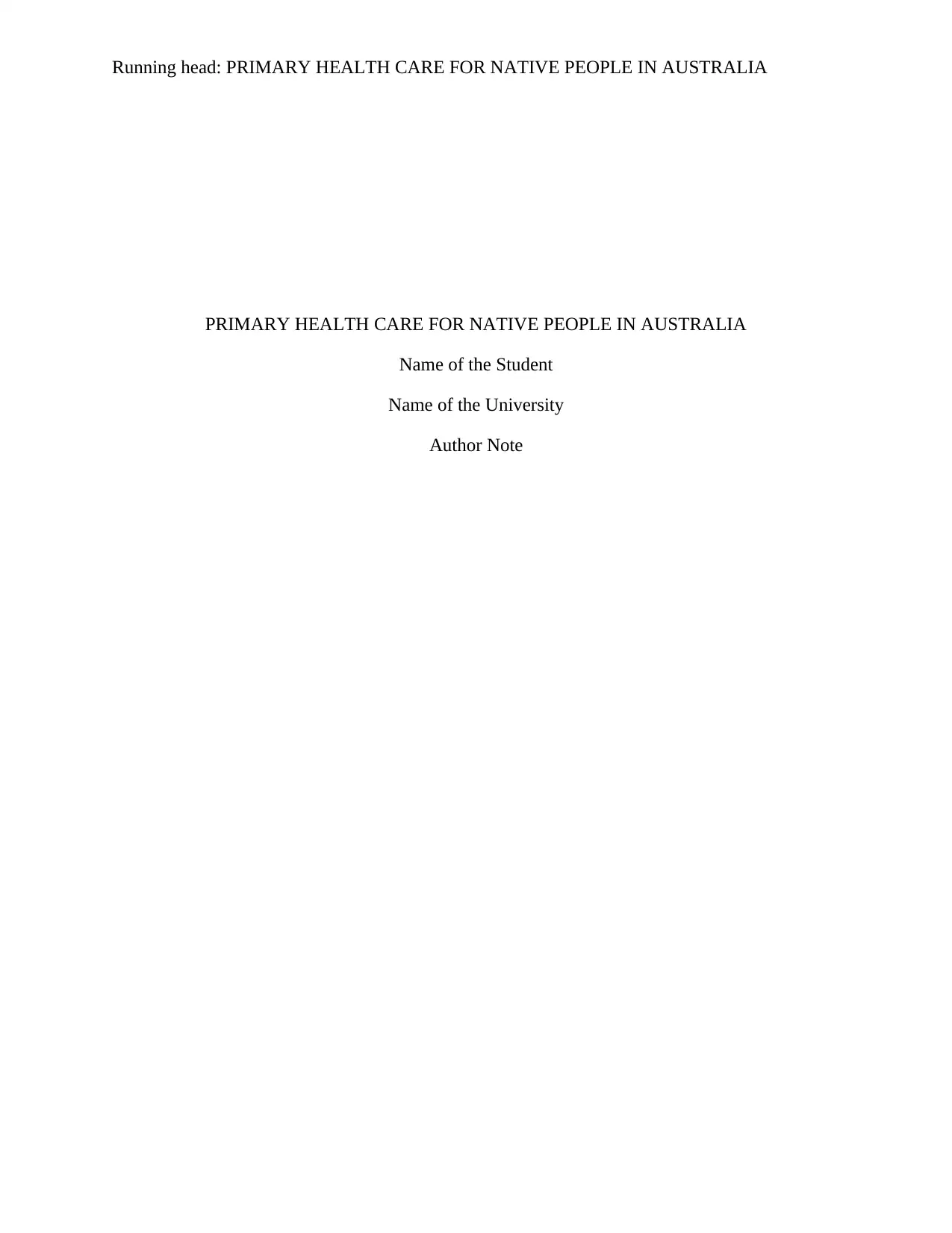
Running head: PRIMARY HEALTH CARE FOR NATIVE PEOPLE IN AUSTRALIA
PRIMARY HEALTH CARE FOR NATIVE PEOPLE IN AUSTRALIA
Name of the Student
Name of the University
Author Note
PRIMARY HEALTH CARE FOR NATIVE PEOPLE IN AUSTRALIA
Name of the Student
Name of the University
Author Note
Paraphrase This Document
Need a fresh take? Get an instant paraphrase of this document with our AI Paraphraser
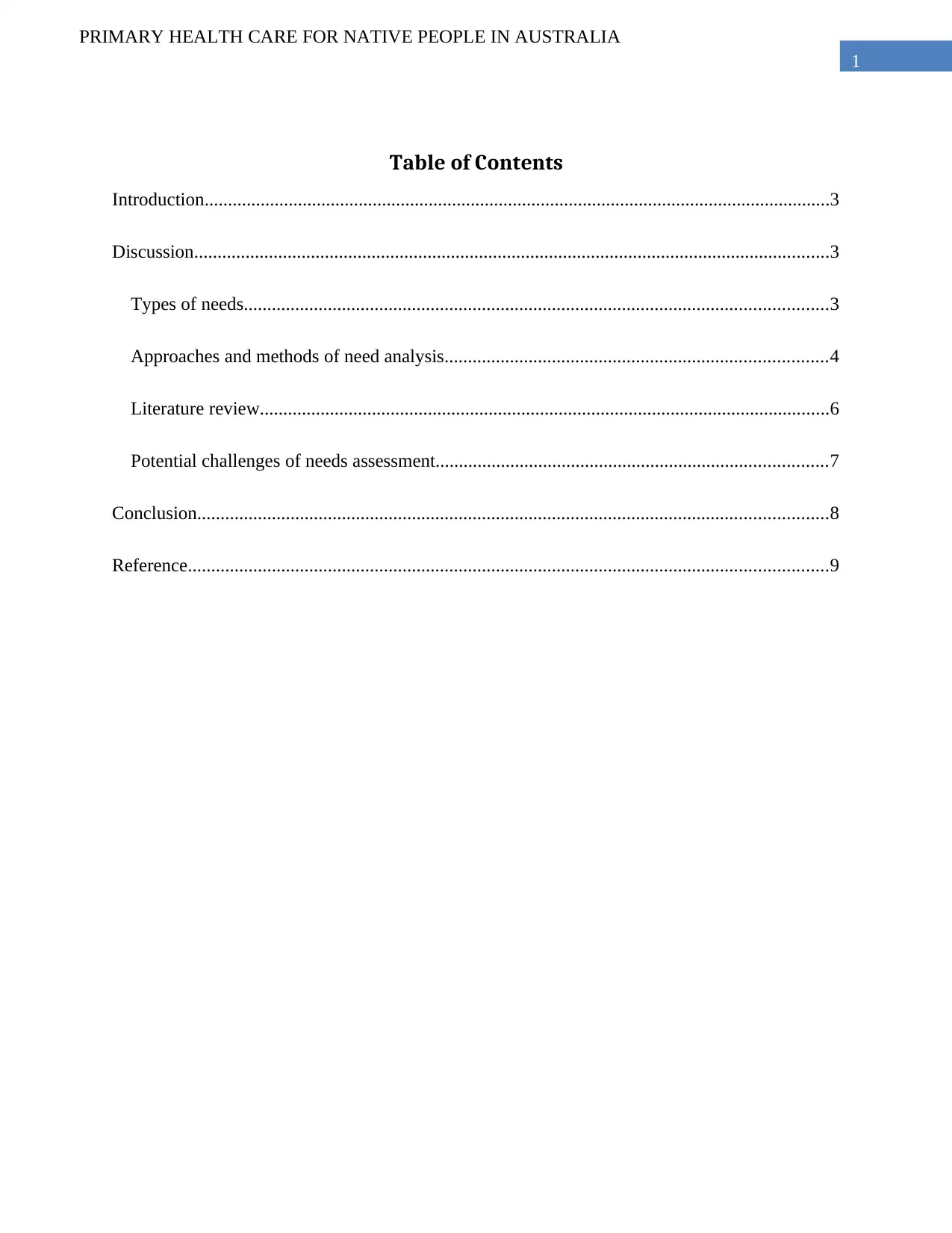
1
PRIMARY HEALTH CARE FOR NATIVE PEOPLE IN AUSTRALIA
Table of Contents
Introduction......................................................................................................................................3
Discussion........................................................................................................................................3
Types of needs.............................................................................................................................3
Approaches and methods of need analysis..................................................................................4
Literature review..........................................................................................................................6
Potential challenges of needs assessment....................................................................................7
Conclusion.......................................................................................................................................8
Reference.........................................................................................................................................9
PRIMARY HEALTH CARE FOR NATIVE PEOPLE IN AUSTRALIA
Table of Contents
Introduction......................................................................................................................................3
Discussion........................................................................................................................................3
Types of needs.............................................................................................................................3
Approaches and methods of need analysis..................................................................................4
Literature review..........................................................................................................................6
Potential challenges of needs assessment....................................................................................7
Conclusion.......................................................................................................................................8
Reference.........................................................................................................................................9
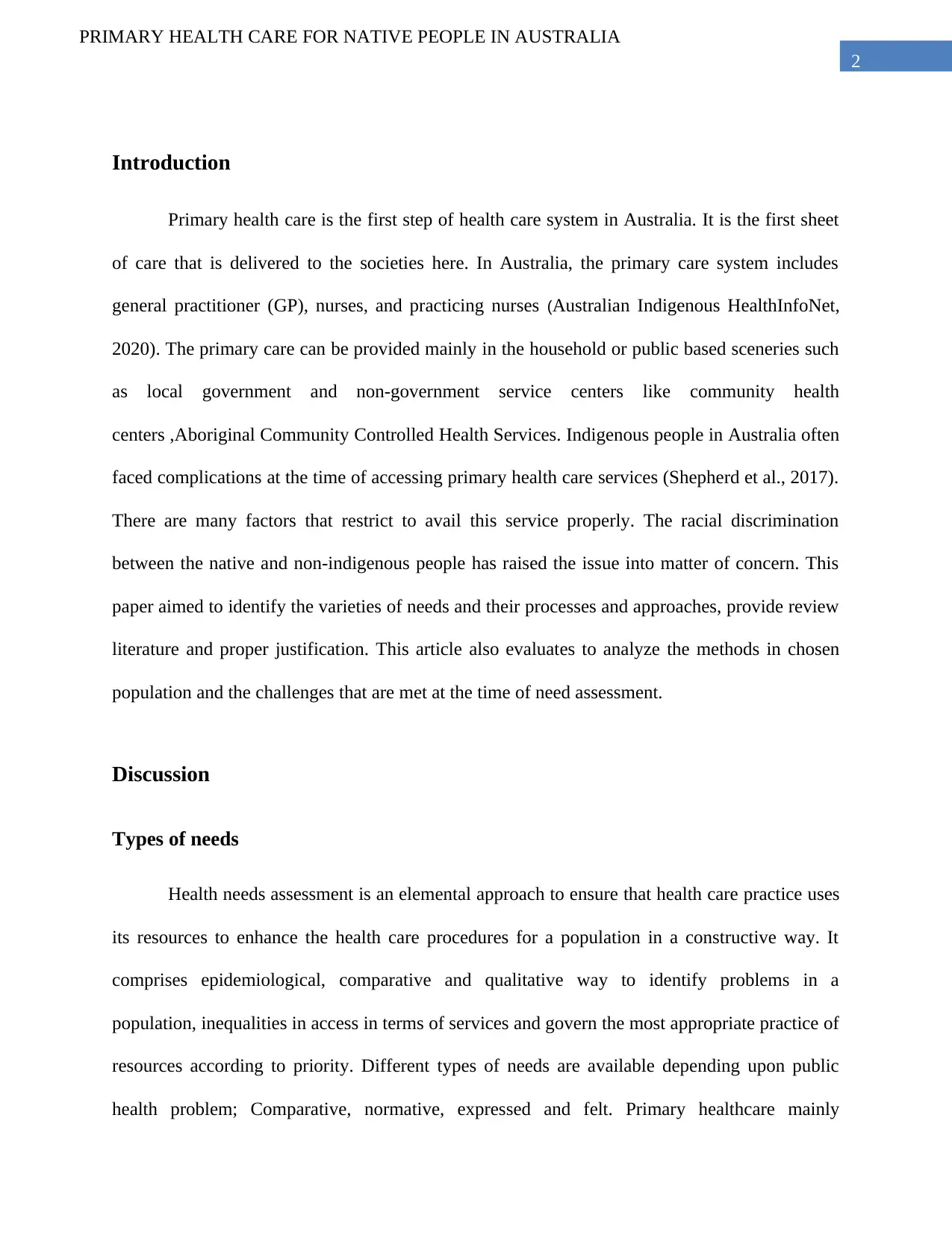
2
PRIMARY HEALTH CARE FOR NATIVE PEOPLE IN AUSTRALIA
Introduction
Primary health care is the first step of health care system in Australia. It is the first sheet
of care that is delivered to the societies here. In Australia, the primary care system includes
general practitioner (GP), nurses, and practicing nurses (Australian Indigenous HealthInfoNet,
2020). The primary care can be provided mainly in the household or public based sceneries such
as local government and non-government service centers like community health
centers ,Aboriginal Community Controlled Health Services. Indigenous people in Australia often
faced complications at the time of accessing primary health care services (Shepherd et al., 2017).
There are many factors that restrict to avail this service properly. The racial discrimination
between the native and non-indigenous people has raised the issue into matter of concern. This
paper aimed to identify the varieties of needs and their processes and approaches, provide review
literature and proper justification. This article also evaluates to analyze the methods in chosen
population and the challenges that are met at the time of need assessment.
Discussion
Types of needs
Health needs assessment is an elemental approach to ensure that health care practice uses
its resources to enhance the health care procedures for a population in a constructive way. It
comprises epidemiological, comparative and qualitative way to identify problems in a
population, inequalities in access in terms of services and govern the most appropriate practice of
resources according to priority. Different types of needs are available depending upon public
health problem; Comparative, normative, expressed and felt. Primary healthcare mainly
PRIMARY HEALTH CARE FOR NATIVE PEOPLE IN AUSTRALIA
Introduction
Primary health care is the first step of health care system in Australia. It is the first sheet
of care that is delivered to the societies here. In Australia, the primary care system includes
general practitioner (GP), nurses, and practicing nurses (Australian Indigenous HealthInfoNet,
2020). The primary care can be provided mainly in the household or public based sceneries such
as local government and non-government service centers like community health
centers ,Aboriginal Community Controlled Health Services. Indigenous people in Australia often
faced complications at the time of accessing primary health care services (Shepherd et al., 2017).
There are many factors that restrict to avail this service properly. The racial discrimination
between the native and non-indigenous people has raised the issue into matter of concern. This
paper aimed to identify the varieties of needs and their processes and approaches, provide review
literature and proper justification. This article also evaluates to analyze the methods in chosen
population and the challenges that are met at the time of need assessment.
Discussion
Types of needs
Health needs assessment is an elemental approach to ensure that health care practice uses
its resources to enhance the health care procedures for a population in a constructive way. It
comprises epidemiological, comparative and qualitative way to identify problems in a
population, inequalities in access in terms of services and govern the most appropriate practice of
resources according to priority. Different types of needs are available depending upon public
health problem; Comparative, normative, expressed and felt. Primary healthcare mainly
⊘ This is a preview!⊘
Do you want full access?
Subscribe today to unlock all pages.

Trusted by 1+ million students worldwide
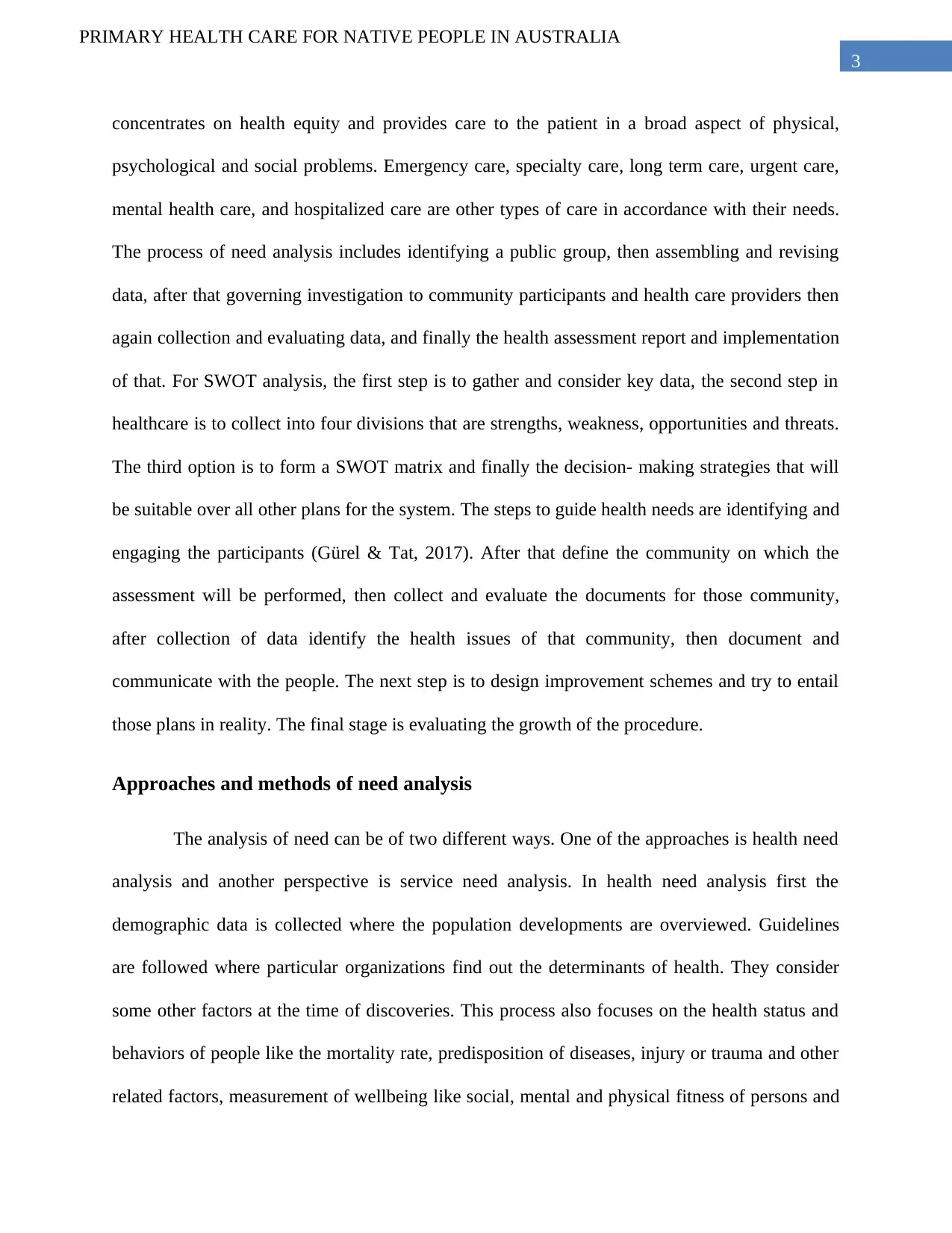
3
PRIMARY HEALTH CARE FOR NATIVE PEOPLE IN AUSTRALIA
concentrates on health equity and provides care to the patient in a broad aspect of physical,
psychological and social problems. Emergency care, specialty care, long term care, urgent care,
mental health care, and hospitalized care are other types of care in accordance with their needs.
The process of need analysis includes identifying a public group, then assembling and revising
data, after that governing investigation to community participants and health care providers then
again collection and evaluating data, and finally the health assessment report and implementation
of that. For SWOT analysis, the first step is to gather and consider key data, the second step in
healthcare is to collect into four divisions that are strengths, weakness, opportunities and threats.
The third option is to form a SWOT matrix and finally the decision- making strategies that will
be suitable over all other plans for the system. The steps to guide health needs are identifying and
engaging the participants (Gürel & Tat, 2017). After that define the community on which the
assessment will be performed, then collect and evaluate the documents for those community,
after collection of data identify the health issues of that community, then document and
communicate with the people. The next step is to design improvement schemes and try to entail
those plans in reality. The final stage is evaluating the growth of the procedure.
Approaches and methods of need analysis
The analysis of need can be of two different ways. One of the approaches is health need
analysis and another perspective is service need analysis. In health need analysis first the
demographic data is collected where the population developments are overviewed. Guidelines
are followed where particular organizations find out the determinants of health. They consider
some other factors at the time of discoveries. This process also focuses on the health status and
behaviors of people like the mortality rate, predisposition of diseases, injury or trauma and other
related factors, measurement of wellbeing like social, mental and physical fitness of persons and
PRIMARY HEALTH CARE FOR NATIVE PEOPLE IN AUSTRALIA
concentrates on health equity and provides care to the patient in a broad aspect of physical,
psychological and social problems. Emergency care, specialty care, long term care, urgent care,
mental health care, and hospitalized care are other types of care in accordance with their needs.
The process of need analysis includes identifying a public group, then assembling and revising
data, after that governing investigation to community participants and health care providers then
again collection and evaluating data, and finally the health assessment report and implementation
of that. For SWOT analysis, the first step is to gather and consider key data, the second step in
healthcare is to collect into four divisions that are strengths, weakness, opportunities and threats.
The third option is to form a SWOT matrix and finally the decision- making strategies that will
be suitable over all other plans for the system. The steps to guide health needs are identifying and
engaging the participants (Gürel & Tat, 2017). After that define the community on which the
assessment will be performed, then collect and evaluate the documents for those community,
after collection of data identify the health issues of that community, then document and
communicate with the people. The next step is to design improvement schemes and try to entail
those plans in reality. The final stage is evaluating the growth of the procedure.
Approaches and methods of need analysis
The analysis of need can be of two different ways. One of the approaches is health need
analysis and another perspective is service need analysis. In health need analysis first the
demographic data is collected where the population developments are overviewed. Guidelines
are followed where particular organizations find out the determinants of health. They consider
some other factors at the time of discoveries. This process also focuses on the health status and
behaviors of people like the mortality rate, predisposition of diseases, injury or trauma and other
related factors, measurement of wellbeing like social, mental and physical fitness of persons and
Paraphrase This Document
Need a fresh take? Get an instant paraphrase of this document with our AI Paraphraser
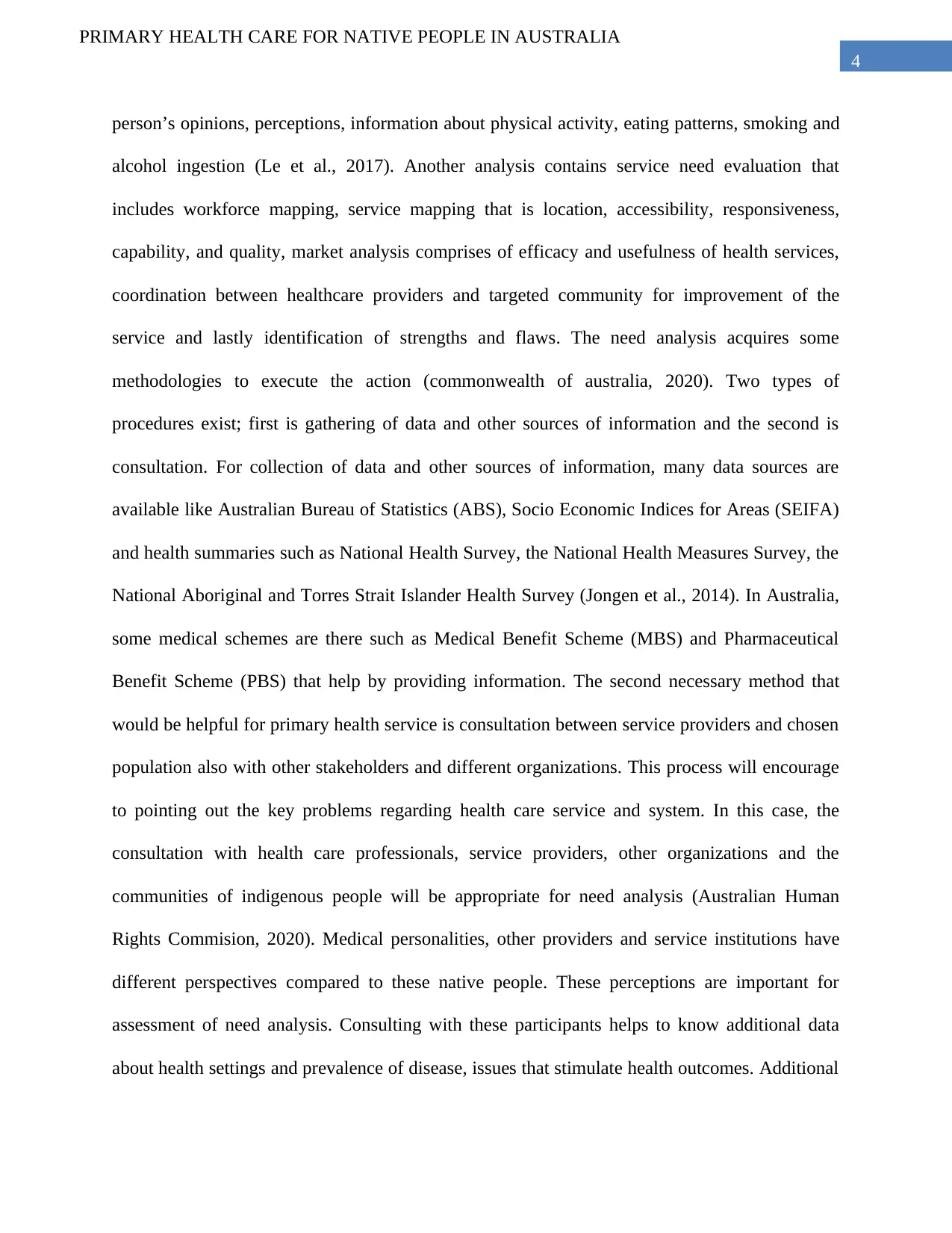
4
PRIMARY HEALTH CARE FOR NATIVE PEOPLE IN AUSTRALIA
person’s opinions, perceptions, information about physical activity, eating patterns, smoking and
alcohol ingestion (Le et al., 2017). Another analysis contains service need evaluation that
includes workforce mapping, service mapping that is location, accessibility, responsiveness,
capability, and quality, market analysis comprises of efficacy and usefulness of health services,
coordination between healthcare providers and targeted community for improvement of the
service and lastly identification of strengths and flaws. The need analysis acquires some
methodologies to execute the action (commonwealth of australia, 2020). Two types of
procedures exist; first is gathering of data and other sources of information and the second is
consultation. For collection of data and other sources of information, many data sources are
available like Australian Bureau of Statistics (ABS), Socio Economic Indices for Areas (SEIFA)
and health summaries such as National Health Survey, the National Health Measures Survey, the
National Aboriginal and Torres Strait Islander Health Survey (Jongen et al., 2014). In Australia,
some medical schemes are there such as Medical Benefit Scheme (MBS) and Pharmaceutical
Benefit Scheme (PBS) that help by providing information. The second necessary method that
would be helpful for primary health service is consultation between service providers and chosen
population also with other stakeholders and different organizations. This process will encourage
to pointing out the key problems regarding health care service and system. In this case, the
consultation with health care professionals, service providers, other organizations and the
communities of indigenous people will be appropriate for need analysis (Australian Human
Rights Commision, 2020). Medical personalities, other providers and service institutions have
different perspectives compared to these native people. These perceptions are important for
assessment of need analysis. Consulting with these participants helps to know additional data
about health settings and prevalence of disease, issues that stimulate health outcomes. Additional
PRIMARY HEALTH CARE FOR NATIVE PEOPLE IN AUSTRALIA
person’s opinions, perceptions, information about physical activity, eating patterns, smoking and
alcohol ingestion (Le et al., 2017). Another analysis contains service need evaluation that
includes workforce mapping, service mapping that is location, accessibility, responsiveness,
capability, and quality, market analysis comprises of efficacy and usefulness of health services,
coordination between healthcare providers and targeted community for improvement of the
service and lastly identification of strengths and flaws. The need analysis acquires some
methodologies to execute the action (commonwealth of australia, 2020). Two types of
procedures exist; first is gathering of data and other sources of information and the second is
consultation. For collection of data and other sources of information, many data sources are
available like Australian Bureau of Statistics (ABS), Socio Economic Indices for Areas (SEIFA)
and health summaries such as National Health Survey, the National Health Measures Survey, the
National Aboriginal and Torres Strait Islander Health Survey (Jongen et al., 2014). In Australia,
some medical schemes are there such as Medical Benefit Scheme (MBS) and Pharmaceutical
Benefit Scheme (PBS) that help by providing information. The second necessary method that
would be helpful for primary health service is consultation between service providers and chosen
population also with other stakeholders and different organizations. This process will encourage
to pointing out the key problems regarding health care service and system. In this case, the
consultation with health care professionals, service providers, other organizations and the
communities of indigenous people will be appropriate for need analysis (Australian Human
Rights Commision, 2020). Medical personalities, other providers and service institutions have
different perspectives compared to these native people. These perceptions are important for
assessment of need analysis. Consulting with these participants helps to know additional data
about health settings and prevalence of disease, issues that stimulate health outcomes. Additional
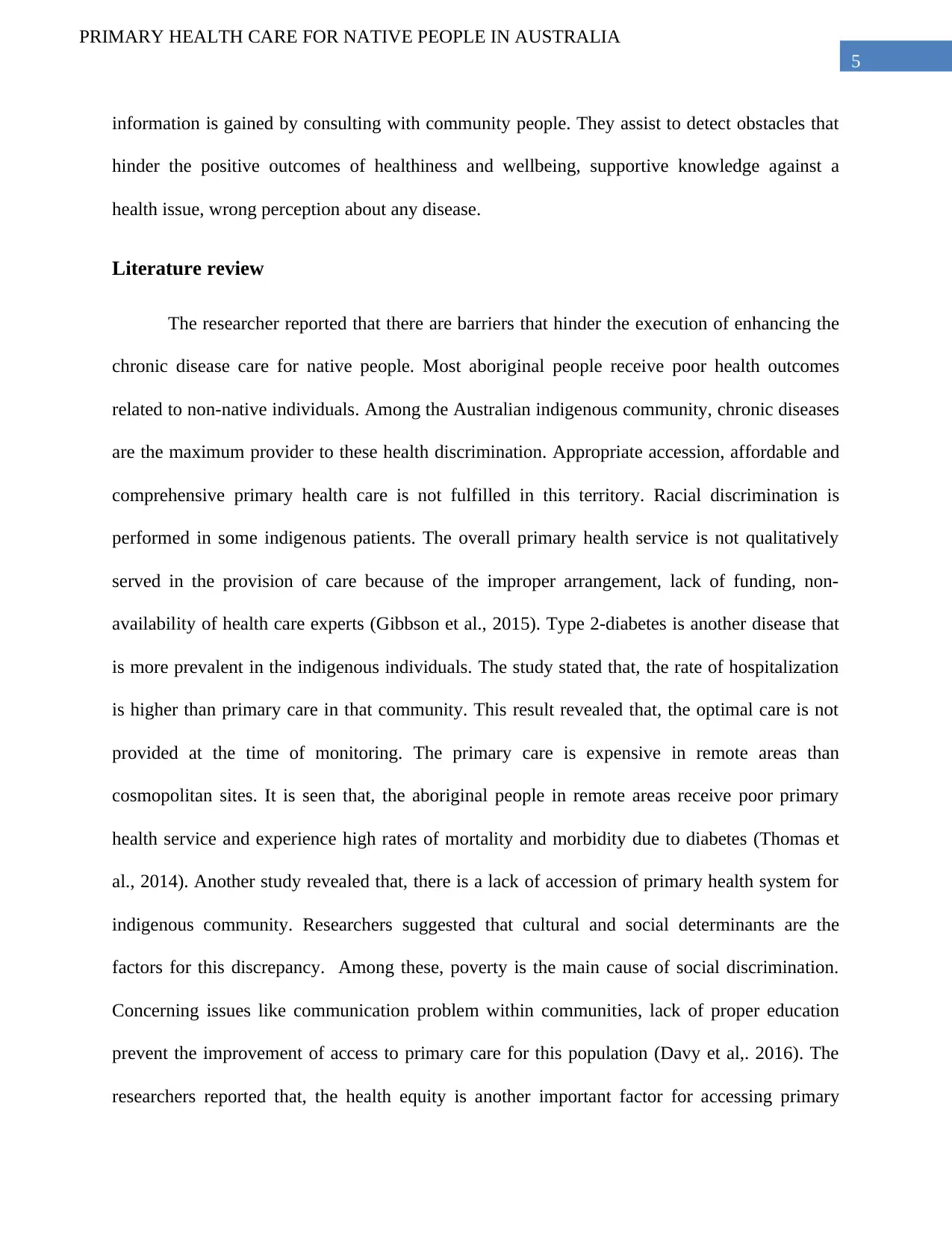
5
PRIMARY HEALTH CARE FOR NATIVE PEOPLE IN AUSTRALIA
information is gained by consulting with community people. They assist to detect obstacles that
hinder the positive outcomes of healthiness and wellbeing, supportive knowledge against a
health issue, wrong perception about any disease.
Literature review
The researcher reported that there are barriers that hinder the execution of enhancing the
chronic disease care for native people. Most aboriginal people receive poor health outcomes
related to non-native individuals. Among the Australian indigenous community, chronic diseases
are the maximum provider to these health discrimination. Appropriate accession, affordable and
comprehensive primary health care is not fulfilled in this territory. Racial discrimination is
performed in some indigenous patients. The overall primary health service is not qualitatively
served in the provision of care because of the improper arrangement, lack of funding, non-
availability of health care experts (Gibbson et al., 2015). Type 2-diabetes is another disease that
is more prevalent in the indigenous individuals. The study stated that, the rate of hospitalization
is higher than primary care in that community. This result revealed that, the optimal care is not
provided at the time of monitoring. The primary care is expensive in remote areas than
cosmopolitan sites. It is seen that, the aboriginal people in remote areas receive poor primary
health service and experience high rates of mortality and morbidity due to diabetes (Thomas et
al., 2014). Another study revealed that, there is a lack of accession of primary health system for
indigenous community. Researchers suggested that cultural and social determinants are the
factors for this discrepancy. Among these, poverty is the main cause of social discrimination.
Concerning issues like communication problem within communities, lack of proper education
prevent the improvement of access to primary care for this population (Davy et al,. 2016). The
researchers reported that, the health equity is another important factor for accessing primary
PRIMARY HEALTH CARE FOR NATIVE PEOPLE IN AUSTRALIA
information is gained by consulting with community people. They assist to detect obstacles that
hinder the positive outcomes of healthiness and wellbeing, supportive knowledge against a
health issue, wrong perception about any disease.
Literature review
The researcher reported that there are barriers that hinder the execution of enhancing the
chronic disease care for native people. Most aboriginal people receive poor health outcomes
related to non-native individuals. Among the Australian indigenous community, chronic diseases
are the maximum provider to these health discrimination. Appropriate accession, affordable and
comprehensive primary health care is not fulfilled in this territory. Racial discrimination is
performed in some indigenous patients. The overall primary health service is not qualitatively
served in the provision of care because of the improper arrangement, lack of funding, non-
availability of health care experts (Gibbson et al., 2015). Type 2-diabetes is another disease that
is more prevalent in the indigenous individuals. The study stated that, the rate of hospitalization
is higher than primary care in that community. This result revealed that, the optimal care is not
provided at the time of monitoring. The primary care is expensive in remote areas than
cosmopolitan sites. It is seen that, the aboriginal people in remote areas receive poor primary
health service and experience high rates of mortality and morbidity due to diabetes (Thomas et
al., 2014). Another study revealed that, there is a lack of accession of primary health system for
indigenous community. Researchers suggested that cultural and social determinants are the
factors for this discrepancy. Among these, poverty is the main cause of social discrimination.
Concerning issues like communication problem within communities, lack of proper education
prevent the improvement of access to primary care for this population (Davy et al,. 2016). The
researchers reported that, the health equity is another important factor for accessing primary
⊘ This is a preview!⊘
Do you want full access?
Subscribe today to unlock all pages.

Trusted by 1+ million students worldwide
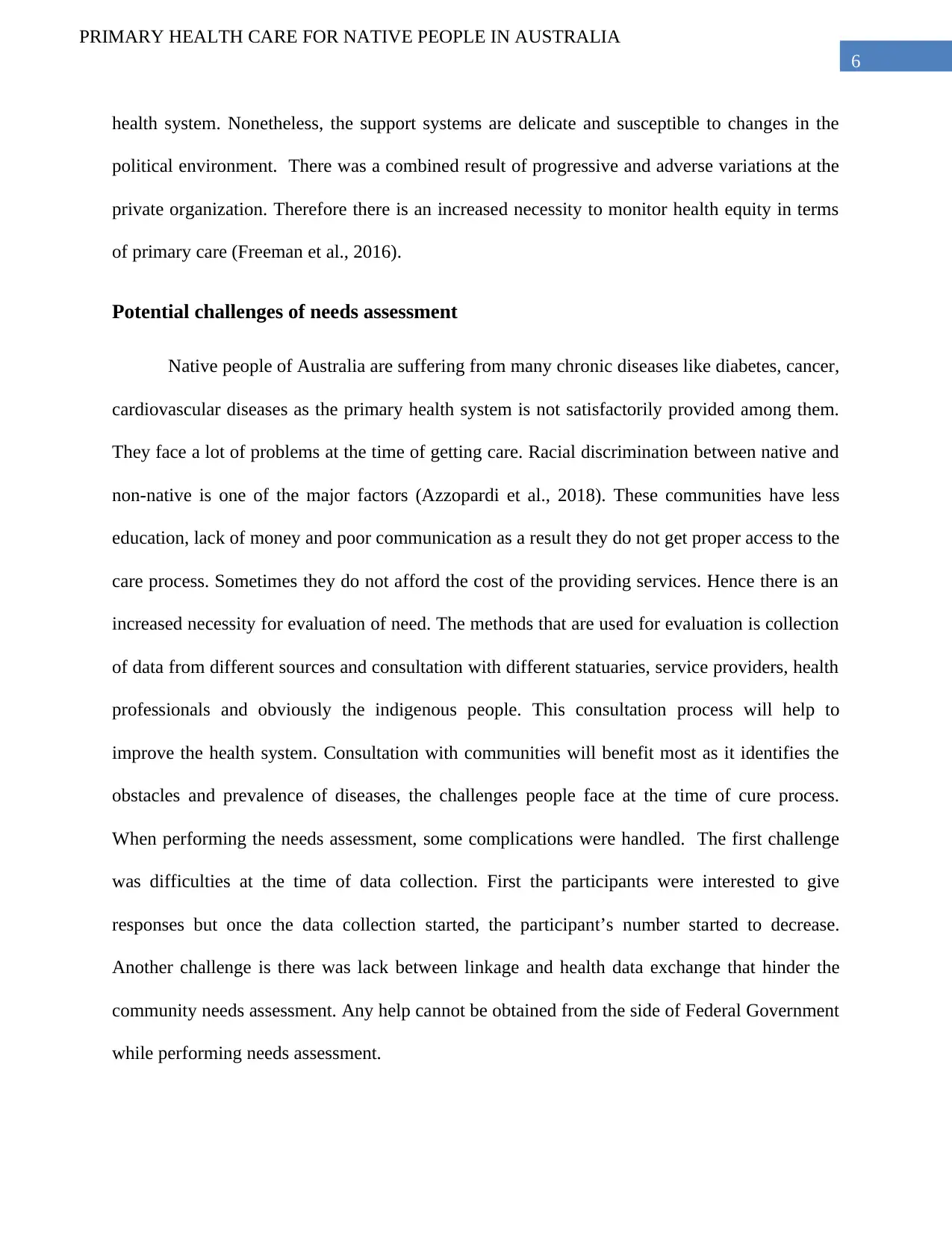
6
PRIMARY HEALTH CARE FOR NATIVE PEOPLE IN AUSTRALIA
health system. Nonetheless, the support systems are delicate and susceptible to changes in the
political environment. There was a combined result of progressive and adverse variations at the
private organization. Therefore there is an increased necessity to monitor health equity in terms
of primary care (Freeman et al., 2016).
Potential challenges of needs assessment
Native people of Australia are suffering from many chronic diseases like diabetes, cancer,
cardiovascular diseases as the primary health system is not satisfactorily provided among them.
They face a lot of problems at the time of getting care. Racial discrimination between native and
non-native is one of the major factors (Azzopardi et al., 2018). These communities have less
education, lack of money and poor communication as a result they do not get proper access to the
care process. Sometimes they do not afford the cost of the providing services. Hence there is an
increased necessity for evaluation of need. The methods that are used for evaluation is collection
of data from different sources and consultation with different statuaries, service providers, health
professionals and obviously the indigenous people. This consultation process will help to
improve the health system. Consultation with communities will benefit most as it identifies the
obstacles and prevalence of diseases, the challenges people face at the time of cure process.
When performing the needs assessment, some complications were handled. The first challenge
was difficulties at the time of data collection. First the participants were interested to give
responses but once the data collection started, the participant’s number started to decrease.
Another challenge is there was lack between linkage and health data exchange that hinder the
community needs assessment. Any help cannot be obtained from the side of Federal Government
while performing needs assessment.
PRIMARY HEALTH CARE FOR NATIVE PEOPLE IN AUSTRALIA
health system. Nonetheless, the support systems are delicate and susceptible to changes in the
political environment. There was a combined result of progressive and adverse variations at the
private organization. Therefore there is an increased necessity to monitor health equity in terms
of primary care (Freeman et al., 2016).
Potential challenges of needs assessment
Native people of Australia are suffering from many chronic diseases like diabetes, cancer,
cardiovascular diseases as the primary health system is not satisfactorily provided among them.
They face a lot of problems at the time of getting care. Racial discrimination between native and
non-native is one of the major factors (Azzopardi et al., 2018). These communities have less
education, lack of money and poor communication as a result they do not get proper access to the
care process. Sometimes they do not afford the cost of the providing services. Hence there is an
increased necessity for evaluation of need. The methods that are used for evaluation is collection
of data from different sources and consultation with different statuaries, service providers, health
professionals and obviously the indigenous people. This consultation process will help to
improve the health system. Consultation with communities will benefit most as it identifies the
obstacles and prevalence of diseases, the challenges people face at the time of cure process.
When performing the needs assessment, some complications were handled. The first challenge
was difficulties at the time of data collection. First the participants were interested to give
responses but once the data collection started, the participant’s number started to decrease.
Another challenge is there was lack between linkage and health data exchange that hinder the
community needs assessment. Any help cannot be obtained from the side of Federal Government
while performing needs assessment.
Paraphrase This Document
Need a fresh take? Get an instant paraphrase of this document with our AI Paraphraser
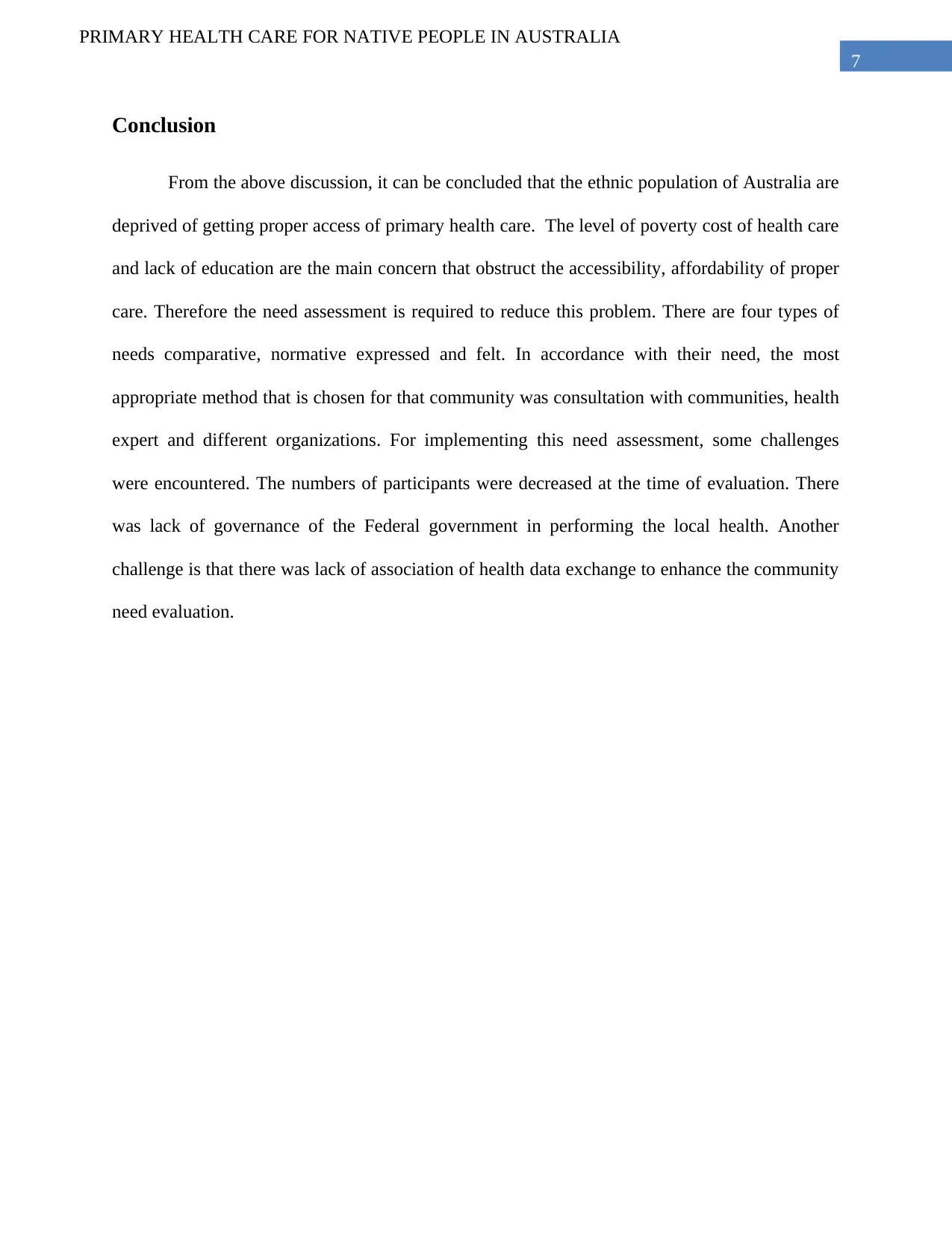
7
PRIMARY HEALTH CARE FOR NATIVE PEOPLE IN AUSTRALIA
Conclusion
From the above discussion, it can be concluded that the ethnic population of Australia are
deprived of getting proper access of primary health care. The level of poverty cost of health care
and lack of education are the main concern that obstruct the accessibility, affordability of proper
care. Therefore the need assessment is required to reduce this problem. There are four types of
needs comparative, normative expressed and felt. In accordance with their need, the most
appropriate method that is chosen for that community was consultation with communities, health
expert and different organizations. For implementing this need assessment, some challenges
were encountered. The numbers of participants were decreased at the time of evaluation. There
was lack of governance of the Federal government in performing the local health. Another
challenge is that there was lack of association of health data exchange to enhance the community
need evaluation.
PRIMARY HEALTH CARE FOR NATIVE PEOPLE IN AUSTRALIA
Conclusion
From the above discussion, it can be concluded that the ethnic population of Australia are
deprived of getting proper access of primary health care. The level of poverty cost of health care
and lack of education are the main concern that obstruct the accessibility, affordability of proper
care. Therefore the need assessment is required to reduce this problem. There are four types of
needs comparative, normative expressed and felt. In accordance with their need, the most
appropriate method that is chosen for that community was consultation with communities, health
expert and different organizations. For implementing this need assessment, some challenges
were encountered. The numbers of participants were decreased at the time of evaluation. There
was lack of governance of the Federal government in performing the local health. Another
challenge is that there was lack of association of health data exchange to enhance the community
need evaluation.
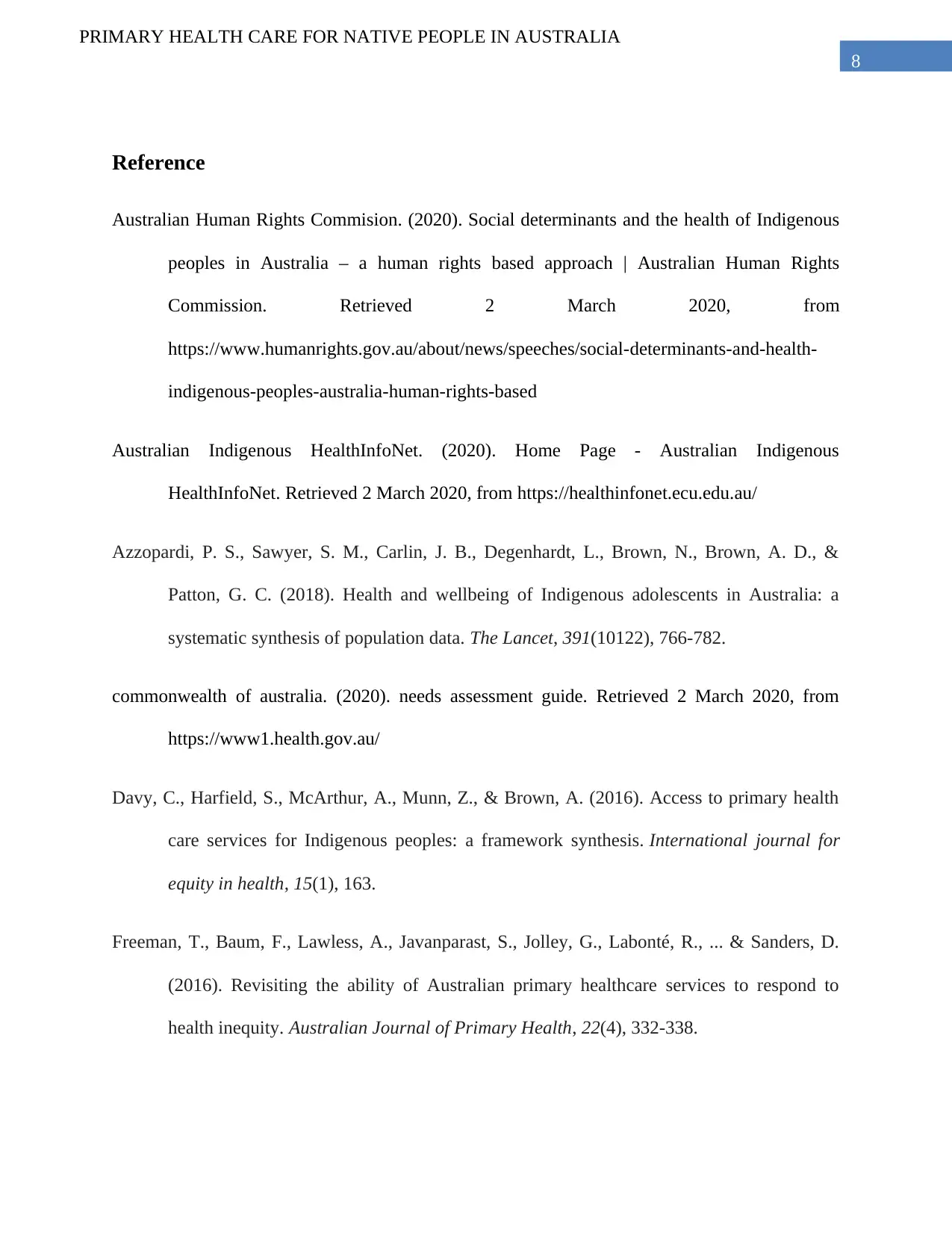
8
PRIMARY HEALTH CARE FOR NATIVE PEOPLE IN AUSTRALIA
Reference
Australian Human Rights Commision. (2020). Social determinants and the health of Indigenous
peoples in Australia – a human rights based approach | Australian Human Rights
Commission. Retrieved 2 March 2020, from
https://www.humanrights.gov.au/about/news/speeches/social-determinants-and-health-
indigenous-peoples-australia-human-rights-based
Australian Indigenous HealthInfoNet. (2020). Home Page - Australian Indigenous
HealthInfoNet. Retrieved 2 March 2020, from https://healthinfonet.ecu.edu.au/
Azzopardi, P. S., Sawyer, S. M., Carlin, J. B., Degenhardt, L., Brown, N., Brown, A. D., &
Patton, G. C. (2018). Health and wellbeing of Indigenous adolescents in Australia: a
systematic synthesis of population data. The Lancet, 391(10122), 766-782.
commonwealth of australia. (2020). needs assessment guide. Retrieved 2 March 2020, from
https://www1.health.gov.au/
Davy, C., Harfield, S., McArthur, A., Munn, Z., & Brown, A. (2016). Access to primary health
care services for Indigenous peoples: a framework synthesis. International journal for
equity in health, 15(1), 163.
Freeman, T., Baum, F., Lawless, A., Javanparast, S., Jolley, G., Labonté, R., ... & Sanders, D.
(2016). Revisiting the ability of Australian primary healthcare services to respond to
health inequity. Australian Journal of Primary Health, 22(4), 332-338.
PRIMARY HEALTH CARE FOR NATIVE PEOPLE IN AUSTRALIA
Reference
Australian Human Rights Commision. (2020). Social determinants and the health of Indigenous
peoples in Australia – a human rights based approach | Australian Human Rights
Commission. Retrieved 2 March 2020, from
https://www.humanrights.gov.au/about/news/speeches/social-determinants-and-health-
indigenous-peoples-australia-human-rights-based
Australian Indigenous HealthInfoNet. (2020). Home Page - Australian Indigenous
HealthInfoNet. Retrieved 2 March 2020, from https://healthinfonet.ecu.edu.au/
Azzopardi, P. S., Sawyer, S. M., Carlin, J. B., Degenhardt, L., Brown, N., Brown, A. D., &
Patton, G. C. (2018). Health and wellbeing of Indigenous adolescents in Australia: a
systematic synthesis of population data. The Lancet, 391(10122), 766-782.
commonwealth of australia. (2020). needs assessment guide. Retrieved 2 March 2020, from
https://www1.health.gov.au/
Davy, C., Harfield, S., McArthur, A., Munn, Z., & Brown, A. (2016). Access to primary health
care services for Indigenous peoples: a framework synthesis. International journal for
equity in health, 15(1), 163.
Freeman, T., Baum, F., Lawless, A., Javanparast, S., Jolley, G., Labonté, R., ... & Sanders, D.
(2016). Revisiting the ability of Australian primary healthcare services to respond to
health inequity. Australian Journal of Primary Health, 22(4), 332-338.
⊘ This is a preview!⊘
Do you want full access?
Subscribe today to unlock all pages.

Trusted by 1+ million students worldwide
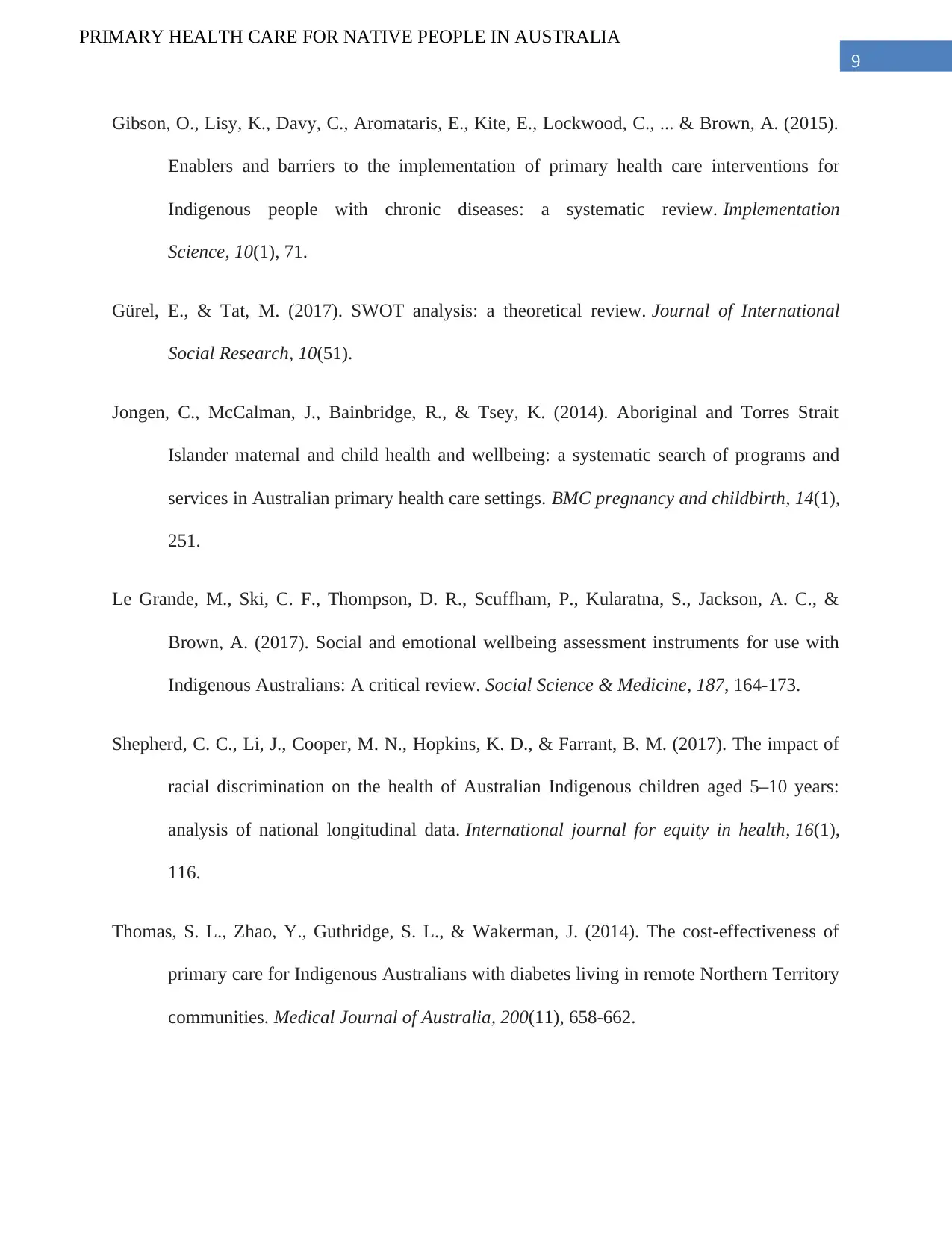
9
PRIMARY HEALTH CARE FOR NATIVE PEOPLE IN AUSTRALIA
Gibson, O., Lisy, K., Davy, C., Aromataris, E., Kite, E., Lockwood, C., ... & Brown, A. (2015).
Enablers and barriers to the implementation of primary health care interventions for
Indigenous people with chronic diseases: a systematic review. Implementation
Science, 10(1), 71.
Gürel, E., & Tat, M. (2017). SWOT analysis: a theoretical review. Journal of International
Social Research, 10(51).
Jongen, C., McCalman, J., Bainbridge, R., & Tsey, K. (2014). Aboriginal and Torres Strait
Islander maternal and child health and wellbeing: a systematic search of programs and
services in Australian primary health care settings. BMC pregnancy and childbirth, 14(1),
251.
Le Grande, M., Ski, C. F., Thompson, D. R., Scuffham, P., Kularatna, S., Jackson, A. C., &
Brown, A. (2017). Social and emotional wellbeing assessment instruments for use with
Indigenous Australians: A critical review. Social Science & Medicine, 187, 164-173.
Shepherd, C. C., Li, J., Cooper, M. N., Hopkins, K. D., & Farrant, B. M. (2017). The impact of
racial discrimination on the health of Australian Indigenous children aged 5–10 years:
analysis of national longitudinal data. International journal for equity in health, 16(1),
116.
Thomas, S. L., Zhao, Y., Guthridge, S. L., & Wakerman, J. (2014). The cost‐effectiveness of
primary care for Indigenous Australians with diabetes living in remote Northern Territory
communities. Medical Journal of Australia, 200(11), 658-662.
PRIMARY HEALTH CARE FOR NATIVE PEOPLE IN AUSTRALIA
Gibson, O., Lisy, K., Davy, C., Aromataris, E., Kite, E., Lockwood, C., ... & Brown, A. (2015).
Enablers and barriers to the implementation of primary health care interventions for
Indigenous people with chronic diseases: a systematic review. Implementation
Science, 10(1), 71.
Gürel, E., & Tat, M. (2017). SWOT analysis: a theoretical review. Journal of International
Social Research, 10(51).
Jongen, C., McCalman, J., Bainbridge, R., & Tsey, K. (2014). Aboriginal and Torres Strait
Islander maternal and child health and wellbeing: a systematic search of programs and
services in Australian primary health care settings. BMC pregnancy and childbirth, 14(1),
251.
Le Grande, M., Ski, C. F., Thompson, D. R., Scuffham, P., Kularatna, S., Jackson, A. C., &
Brown, A. (2017). Social and emotional wellbeing assessment instruments for use with
Indigenous Australians: A critical review. Social Science & Medicine, 187, 164-173.
Shepherd, C. C., Li, J., Cooper, M. N., Hopkins, K. D., & Farrant, B. M. (2017). The impact of
racial discrimination on the health of Australian Indigenous children aged 5–10 years:
analysis of national longitudinal data. International journal for equity in health, 16(1),
116.
Thomas, S. L., Zhao, Y., Guthridge, S. L., & Wakerman, J. (2014). The cost‐effectiveness of
primary care for Indigenous Australians with diabetes living in remote Northern Territory
communities. Medical Journal of Australia, 200(11), 658-662.
Paraphrase This Document
Need a fresh take? Get an instant paraphrase of this document with our AI Paraphraser

10
PRIMARY HEALTH CARE FOR NATIVE PEOPLE IN AUSTRALIA
PRIMARY HEALTH CARE FOR NATIVE PEOPLE IN AUSTRALIA
1 out of 11
Related Documents
Your All-in-One AI-Powered Toolkit for Academic Success.
+13062052269
info@desklib.com
Available 24*7 on WhatsApp / Email
![[object Object]](/_next/static/media/star-bottom.7253800d.svg)
Unlock your academic potential
Copyright © 2020–2025 A2Z Services. All Rights Reserved. Developed and managed by ZUCOL.





